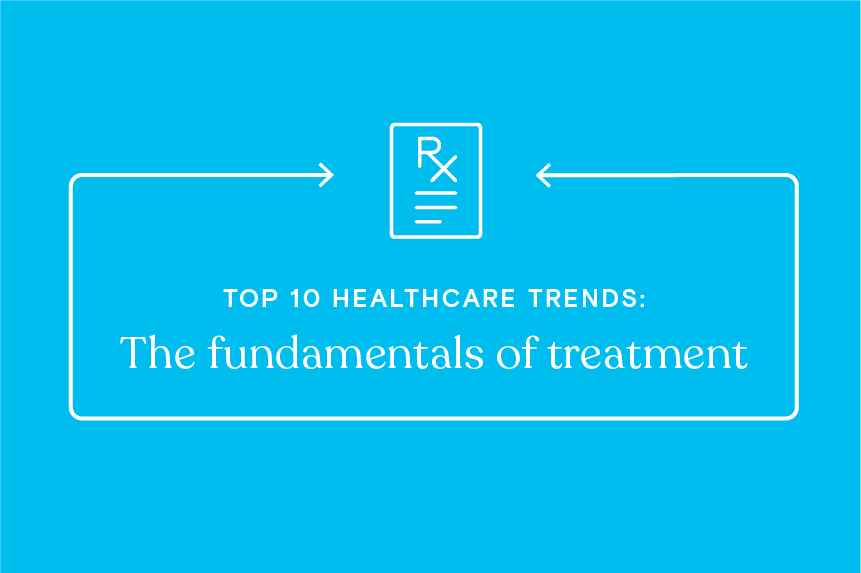The second annual Definitive LIVE! took place a month ago, but the insightful keynote from Definitive Healthcare President Robert Musslewhite is still top of mind for this writer.
I’ve been mulling over one of the presentation’s themes in particular: the fundamentals of treatment are absolutely changing—and the data show it.
If you missed the event, you’ll definitely want to check out the first two parts of our recap series that address Robert’s core themes, “The Perfect Storm” and “The Healthcare Financial Spreadsheet.”
All caught up? Great! Let’s dig into the three trends that define the changing face of healthcare:
- Care is increasingly shifting from inpatient to outpatient settings.
- Remote patient monitoring (RPM) is growing rapidly.
- The U.S. is facing a mental health epidemic that demands investment and innovation.
The shift to outpatient care has arrived
We’ve been talking about the ongoing shift from inpatient to outpatient care for a while, but the latest claims data make it clear this trend is just getting started.
Hospital surgical procedure volume dropped 7% between 2019 and 2021, while ambulatory surgical procedures rose 20% in the same period.
And did you know that less than a third of the 2.4 billion procedure claims we tracked through November 2021 originated at a hospital facility? That’s a 36.7% drop from 2016.
So who’s picking up the slack in care?
Some of it has fallen to physician groups, which often partner with hospitals and health systems to expand their own service offerings while keeping those facilities’ patients in network. As a result, ambulatory surgical centers are seeing increased demand: more than 15 million patients received care at one of these facilities in 2021.
Robert points out, “COVID-19 doesn’t appear to be entirely to blame for this shift,” as physicians’ treatment of patients at non-hospital locations has been slowly rising since before the pandemic. Based on our data, I certainly agree.
Remote patient monitoring is enjoying a renaissance
The shift from inpatient to outpatient care also means that more patients are recovering from treatment or receiving telecare at home—or in other settings where physicians can’t easily monitor their progress.
This change has led to explosive growth in remote patient monitoring—the practice of using remote technology to collect clinical data on patients outside of typical care settings.
The Centers for Medicare and Medicaid Services (CMS) have added six new codes to the RPM category since 2019, and our data show that usage of those codes more than doubled between 2020 and 2021.
Especially for patients with chronic conditions, RPM makes ongoing clinical assessment far more manageable and less disruptive of daily living. Rather than taking regular trips to the doctor to monitor crucial health metrics, patients with chronic conditions like diabetes, heart disease or inflammatory bowel disease are increasingly able to check and report their glucose levels, blood pressure, weight and more to their doctors, all without leaving their home.
The data reflect physicians’ excitement around RPM for chronic illness: RPM claims related to chronic conditions jumped nearly 150% in volume from 2020 to 2021.
Of course, not all chronic conditions are physiological. The rise of chronic mental health conditions like depression and anxiety is also benefitting from new opportunities in remote care.
America faces a mental health epidemic—but there’s hope in new tech
At first glance, the numbers seem bleak. Two in five US adults report symptoms of anxiety or depression, but fewer than half of those individuals receive treatment, according to a recent Kaiser Family Foundation survey.
And then we consider these figures from the Mental Health America Foundation:
- 15% of young Americans have experienced depression in the past year
- More than 2.5 million youths have severe depression
- More than 60% of those youths don’t receive mental health treatment
While the situation is absolutely concerning and requires an immense amount of investment to fix, there’s also some hope on the horizon, in the form of new approaches to treatment and new technologies to aid that treatment.
As discussed in Definitively Speaking Episode 7, Americans seem more comfortable talking about and receiving treatment for mental health than ever before. And providers like CVS Health are encouraging de-stigmatization by incorporating mental healthcare in their retail clinic care model.
For many people, becoming more resilient to the everyday stressors that can contribute to depression and anxiety is as simple as “brushing your brain,” or keeping up with simple habits like self-care, daily exercise and a nutritious diet.
People who need professional help managing their mental health can benefit from the proliferation of telemedicine and related technologies following COVID-19. While less than 1% of all mental health visits were performed virtually in February 2020, that figure rose to 39% in November 2021 and has held steady since that time.
Likewise, four of the top five diagnoses made over telemedicine in 2021 were related to mental health. This technology shows great promise in promoting access to the mental healthcare that so many people need–and we’ll dig even deeper into the data behind that tech in the final entry to this recap series.
Learn more
At this point, it’s accepted wisdom that COVID-19 has changed many fundamental aspects about healthcare and its delivery. But as Robert noted, some of the most interesting trends in care are rooted in shifts that began before this coronavirus was even a blip on the radar.
Healthcare commercial intelligence offers insight into these trends and can help industry players make savvy strategic decisions based on the past, present and projected future of various markets, whether hyper-local or international.
Want a hands-on demonstration of how our data, analytics and expertise can help grow your business? Sign up for a free trial today.
To catch the final part of Robert’s keynote recap, check back on our blog next week, when we’ll be covering what he calls “the technical revolution in care delivery.” Don’t miss it!





